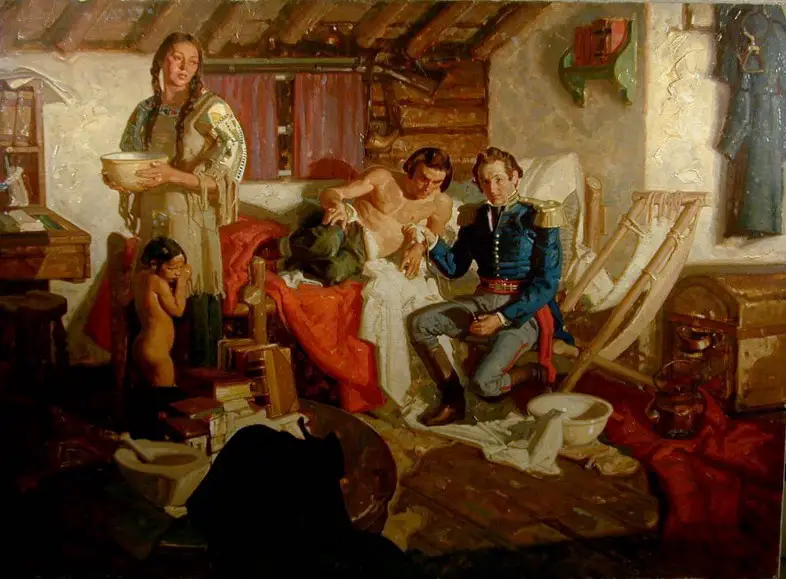 he problem we keep facing even in modern medicine is that we keep forgetting how different and unique each organism is by the way it reacts to different events that damage the body. Until the late 18th century, strange medical anomalies of people surviving fatal blows or other medical complications were seen as miracles.
he problem we keep facing even in modern medicine is that we keep forgetting how different and unique each organism is by the way it reacts to different events that damage the body. Until the late 18th century, strange medical anomalies of people surviving fatal blows or other medical complications were seen as miracles.
It wasn’t until 1822 that a young Canadian merchant by the name of Alexis St. Martin was accidentally shot in the stomach. Martin came to Mackinac Island in Michigan to acquire some more fur coats which he was trading at a national level. As he was walking near a pond a hunter looking for ducks mistakenly shot Martin from a very close distance.
Close to where Martin got shot was a military hospital so the hunter quickly rushed him there. Due to the lack of medical advancement, such close-range shot wounds were considered fatal and many surgeons would just pump the dying patient with morphine to ease his or her death.
The buckshot wound pierced his stomach, breaking some ribs along the way and also damaging one of his lungs.
At the military hospital, he was attended by Dr. William Beaumont who saw his fair share of fatal wounds in his medical career. Dr. Beaumont managed to save Martin, but in the process of stopping the severe bleeding, he left quite a big hole in Martin’s stomach.
“I found a part of the lung as extensive as a turkey’s egg, distending through the outer injury, slashed and consumed,” Beaumont later stated, “and quickly underneath this, another projection, which, on additional assessment, end up being a segment of the stomach, gashed through the entirety of its jackets, and spilling out the food he had taken for his morning meal, through a hole sufficiently large to concede the pointer.”
Dr. William Beaumont
During that period of time, there was no such thing as plastic surgery that would allow the closing of this hole, so Martin had to learn to live with it.
Living with a hole in the stomach
Besides having open access to the inside of his body which could cause severe infections, Martin had another problem he had to live with. Most of what he would eat would come out of the whole rather than being digested.
When the incident happened Martin was only 28 years of age, young enough for most of the wound to heal by itself. After two months the wound closed about 70%, shifting from the size of an egg to a nickel. This meant that most of the food would end up staying in the stomach rather than getting out of the whole, however, infections were still a major risk.

Dr. Beaumont was very relieved to see the wound healing and leaving an opening as this gave him a chance to analyze Martin’s digestive system. At the time not much was known about the digestive system. Even if the wound was mostly healed, Martin was still weak and needed more time to recover, the perfect time for Dr. Beaumont to analyze his digestive system.
Martin was asked by the doctor to sign a contract that would give him permission to make various tests on him. As Martin was illiterate he signed the contract without reading it. Many say he did this as he was ashamed to show that he was illiterate although illiteracy was quite common in the 19th century. At least Martin was getting paid for being a “lab rat.”
Unethical tests

Dr. Beaumont performed over 200 tests on Martin, many of them being very unethical to today’s standards. At the time there wasn’t such thing as an ethical code of conduct so pretty much everything was permitted within the medical industry.
The sort of unethical tests Beaumont would perform was to take food out of Martin’s stomach and analyze its composition as well as how the stomach was changing the consistency of the food.
Another interesting although the very unethical experiment was putting food in a cloth and showing the cloth through the stomach whole and living it inside the stomach for a couple of hours. The food wrapped around the cloth worked as a tea bag for the gastric system. That is how Beaumount discovered that the way digestion functions was by gastric acids dissolving the food.

All of Dr. Beaumont’s findings from these experiments were published in a book from 1929 entitled Gastric Juice and The Psychology of Digestion by Sir William Osler. Whilst performing all of these experiments on Martin, he promised that after he finished all of his experiments he would close the hole although he was never able to without killing Martin.
Despite this complication and all the tests performed, Martin managed to live until 1880 and Dr. William Beaumont passed away in 1853.
Avid Writer with invaluable knowledge of Humanity!
Upcoming historian with over 30 million views online.
“You make your own life.”





